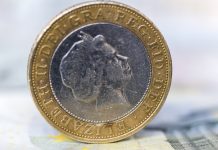The pound extended its gains against the euro on Tuesday thanks to softer data from Germany and despite poor UK retail sales data. The pound euro exchange rate climbed another 0.1% to end the session at €1.1355 for the pound. Sterling is now trading just over 0.3% lower than where it was prior to the Bank of England (BoE) interest rate hike announcement last week.
| What do these figures mean? |
|---|
|
When measuring the value of a pair of currencies, one set equals 1 unit and the other shows the current equivalent. As the market moves, the amount will vary from minute to minute. For example, it could be written: 1 GBP = 1.13990 EUR Here, £1 is equivalent to approximately €1.14. This specifically measures the pound’s worth against the euro. If the euro amount increases in this pairing, it’s positive for the pound. Or, if you were looking at it the other way around: 1 EUR = 0.87271 GBP In this example, €1 is equivalent to approximately £0.87. This measures the euro’s worth versus the British pound. If the sterling number gets larger, it’s good news for the euro. |
The pound traded higher early on Tuesday, however it pulled back after the British Retail Consortium (BRC) released its latest retail sales figures. The data showed that retails sales growth slumped sharply in October. Like for like (LFL) sales declined 1%, reversing from a 1.9% increase in September. LFL growth figure is a more reliable indicator of current sales trade because it measures growth in sales while adjusting the data for new and divested businesses, or any other activity that artificially enlarge a company’s sales activity.
Another data point that interested investors was that non-food sales dropped the most in the last 5 years. This shows that the UK consumer is focusing on essential items in their shopping basket and reining in their spending on nonessential items. The reason behind the changing shopping habits of the UK consumer appears to be the increasingly tough conditions that households are facing. Prices of goods are rising, with inflation at 3% and wages are falling in real terms. This is leaving the consumer little choice but to cut back spending on nonessential items.
| Why does poor economic data drag on a country’s currency? |
|---|
| Slowing economic indicators point to a slowing economy. Weak economies have weaker currencies because institutions look to reduce investments in countries where growth prospects are low and then transfer money to countries with higher growth prospects. These institutions sell out of their investment and the local currency, thus increasing supply of the currency and pushing down the money’s worth. So, when a country or region has poor economic news, the value of the currency tends to fall. |
There is no high-impacting UK economic data due to be released today. Instead, investors may bring their focus back towards Brexit following the publication of post EU-trade legislation by members of the British parliament. The new legislation sets out to provide the UK with a framework for independent trade once the UK leaves the EU. The aim of this legislation is to provide some level of certainty to businesses and trading partners. If pound investors consider the legislation to be comprehensive, the pound could find itself supported. Any factors that aid a smooth Brexit are favourable for the pound.
| Why is a smooth Brexit good for the pound? |
|---|
| A smoother Brexit would be a scenario in which the economic consequences of leaving the European Union are minimised. This is favourable for the pound because the less the Brexit impact on the economy, the more likely that foreign investors will remain interested in the UK. Foreign investors need sterling to invest in the country and so the more GBP is purchased, the higher the demand and, thus, an increase in the currency’s value. |
Euro Weak Due to Soft German Data
The euro came under pressure once again in the previous trading session. Sentiment towards the common currency declined following weaker than expected German industrial production numbers. Industrial production in the powerhouse of Europe declined by 1.6% in October, a significant reversal from a growth of 2.6% last month. However, despite the poor headline figures, factory orders remain robust, so analysts and investors remain confident that this is just a blip along the road, rather than a serious reversal in fortunes for German Industry.
Today sees a light eurozone economic calendar, instead investors could look ahead to the eurozone growth forecasts due to be released by the European Central Bank on Thursday. Eurozone economic strength has been a big story for 2017, investors will be keen to see solid forecasts for next year. Strong numbers could increase the demand for the euro.
|
This article was initially published on TransferWise.com from the same author. The content at Currency Live is the sole opinion of the authors and in no way reflects the views of TransferWise Inc. |





